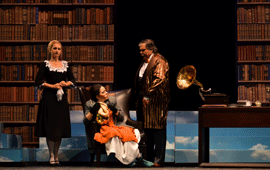> [Archived] Chronicles

My Fair Lady in New Clothes, in Constanța
Lucia Mihalache became a charismatic Eliza, beautiful, charming and expressive (even though the initial text was supposed to be much more mangled, the passage to the elegant speech more nuanced, the first walk on heels clumsier, just like the sitting posture, to enhance the contrast), singing with security and a pleasant voice. The actor Liviu Manolache was convincing as Higgins, also performing the musical parts with accuracy and especially with a rhythmical precision (which is extremely important in the relationship with the orchestra and in ensembles). Gabriela Dobre became a Mrs. Pierce (far from the consecrated 'model' of the dueña), supple, coquette, with humorous outbursts. The soprano Gladiola Nițulescu (from the Operetta) approached the role of Mrs. Higgins in prose with her usual verve. Bogdan Sandu was… what he should have been as Freddy, the base Constantin Acsinte reviving Pickering's character in his sometimes dazed manner, other times with the English 'morgue' of the 'colonel' with a humour that shows rather from the situations and reactions, and base Mihnea Lamatic (from the NBO) became Doolittle once again, singing, dancing, speaking in a way that he intends close to that of a true 'dustman'. Hence, a large cast being involved in the creation of a unitary coherent performance, that does not lack dancing (street or ballroom) in the choreography imagined by Mihail Mândruțiu, benefiting from the art direction thought out by Adriana Grand - multicoloured costumes of the early 20th century (maybe too presentable for the florists), functional background, with a fixed structure (panel-columns, stairs always with 'white clouds on the blue sky') and screen-panels between the paintings, lovely decorated with intensely coloured 'photos', adapted to the respective moment - flowers, a horse (obviously white), the same clouds etc. Everything has an air of cheerfulness and a certain poesy, the action progresses quite fluently (the pauses between the prose and the singing, when the lead singer awaits the coordination with the orchestra, will probably disappear in the following shows), the directing is logical, of traditional coordinates, but with 'jokes' that, due to repetition, become trivial - in every verse from Eliza's aria appear, one by one, in identical movement, the soubrettes (who, anyway, at 3 a.m. are impeccably dressed in black, with boots, while Mrs. Pierce is, naturally, in a nightgown and bonnet), every ensemble of the street parade through the auditorium, on the same path, in the same manner etc., with the lovely involvement of the audience through the 'dialogue' with the florists or with other characters with 'less manners'.
The choir (prepared, as usual, by Adrian Stanache) sounded better and integrated excellently in the scenic movement, and the orchestra had a difficult mission, same as conductor's Gheorghe Stanciu who, with his experience and calm (often… apparent) managed to follow and balance especially the evolution of the lead singers (who wear though lanyard-microphone), some extra attention being asked either for the debutants, or the singing-actors, the result however being worthy of applause, like the whole representation has proven, because the extremely large audience reacted promptly to any tag line, aria, duet or ensemble, in the end the enthusiasm becoming general, and the congratulations measuring up, which, after all, remains the most important.
Translated by Alexandra Ilie
MTTLC, Bucharest University














